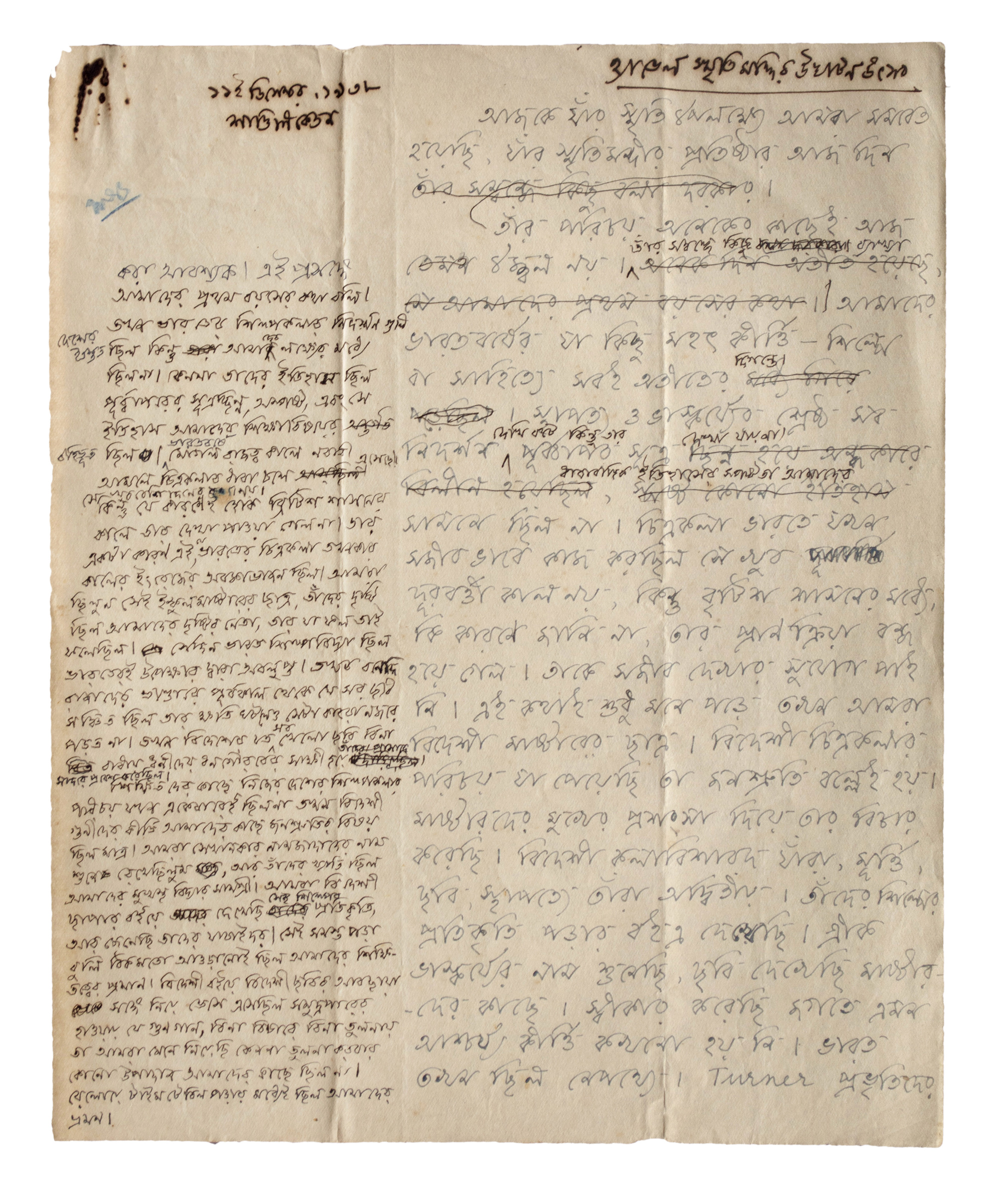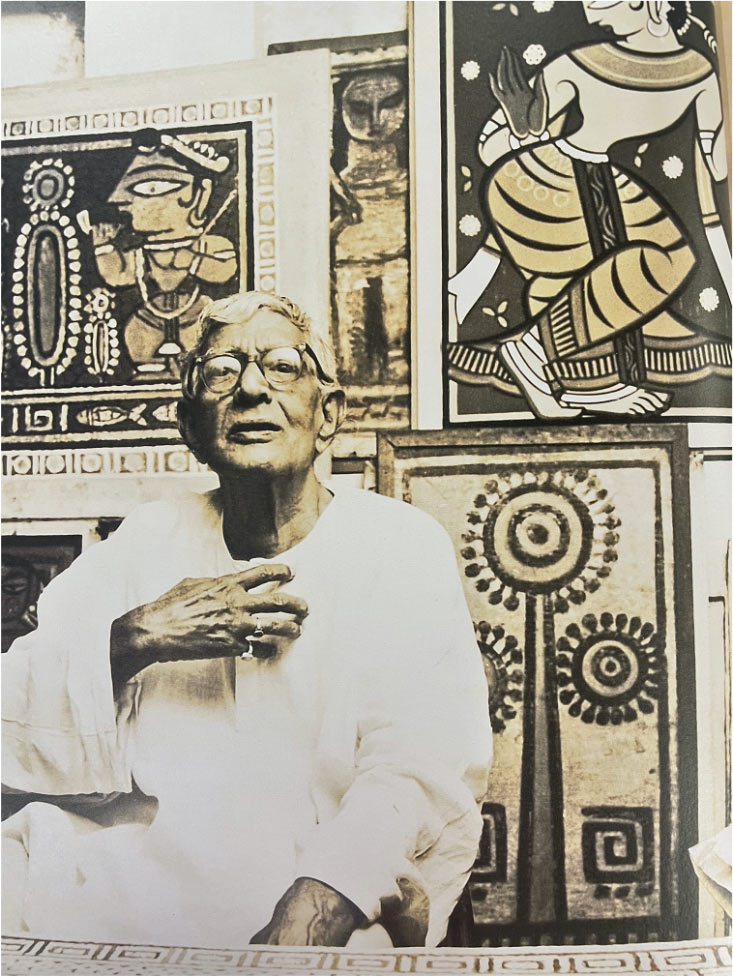
Dhurjati Prasad Mukherjee
₹ 1,00,000

₹ 1,00,000

₹ 1,00,000

₹ 1,00,000

₹ 1,00,000

₹ 1,00,000

₹ 1,00,000

₹ 1,00,000

₹ 13,44,000
Sold

₹ 1,00,000

₹ 11,20,000
Sold

₹ 2,90,000
Sold

₹ 20,000
Sold

Balaichand Mukhopadhyay
Estimate
₹ 10,000 -
₹ 15,000
Read More

Balaichand Mukhopadhyay
Estimate
₹ 10,000 -
₹ 15,000
Read More

Dhurjati Prasad Mukherjee
Estimate
₹ 10,000 -
₹ 15,000
Read More

Tarashankar Bandopadyay
Estimate
₹ 20,000 -
₹ 30,000
Read More

Subodh Bose
Estimate
₹ 10,000 -
₹ 15,000
Read More

Jyotirmoy Roy
Estimate
₹ 10,000 -
₹ 15,000
Read More

Rabindranath Tagore
Estimate
₹ 20,000 -
₹ 30,000
Read More

Rabindranath Tagore
(1931)
Estimate
₹ 5,000 -
₹ 15,000
Read More

Sachindranath Adhikary
Estimate
₹ 7,000 -
₹ 11,000
Read More

Rabindranath Tagore
(1943)
Estimate
₹ 30,000 -
₹ 50,000
Read More

Lila Majumdar
Estimate
₹ 15,000 -
₹ 23,000
Read More

Untitled (View of Mountains in Dehradun)
Estimate
₹ 4,00,000 -
₹ 6,00,000
Read More

UNTITLED (Poem)
Estimate
₹ 10,00,000 -
₹ 12,00,000
Read More

Untitled (Palash Tree with Birds)
Estimate
₹ 4,00,000 -
₹ 6,00,000
Read More

Untitled (Boat on Padma near Shilaidaha)
Estimate
₹ 7,00,000 -
₹ 10,00,000
Read More

Untitled (Bamboo Bushes)
Estimate
₹ 5,00,000 -
₹ 10,00,000
Read More

Untitled (Poppies through a Window in Kalimpong)
Estimate
₹ 50,000 -
₹ 1,00,000
Read More

Untitled (Mountain View in Dehradun)
Estimate
₹ 75,000 -
₹ 1,00,000
Read More

Romain Rolland
(1953)
Estimate
₹ 30,000 -
₹ 50,000
Read More

MUKUL DEY (1895 - 1989)
Estimate
₹ 1,00,000 -
₹ 1,50,000
Read More

Academy of Fine Arts
Estimate
₹ 2,000 -
₹ 3,000
Read More
Sunil Madhav Sen (1910-1979) was an artist whose work reflected an abiding intimacy with the land and ethos of Rural Bengal. Quietly perceptive and inwardly alert, he drew inspiration from the textured rhythms of village life and the unadorned poetry of everyday moments. Rather than seeking recognition, he remained committed to authenticity - shaping a visual language that was contemplative, grounded and steeped in lived memory.
Read More
Various organizations have been working for the advancement of art. From the pages of history, we learn that the first such organization in Calcutta was founded in 1830, named the Brush Club. At that time Prince Dwarakanath Tagore was at the forefront among several Indian and British entrepreneurs. Its lifespan was short. Over time, many organizations were established one after another, but with short lifespans. The Indian Society of Oriental Art founded in 1907, is the only one that remains active to this day. In recent time, one of the active institutions of this kind is Prinseps.
Read More
The first of the transcripts documenting the formation of the 'Calcutta Group' , a letter dated March 1942 written by Subho Tagore in Calcutta to Rathin Maitra in Pabna foreseeing a vision in creating something to illuminate the nation's art!
Read More
Shanu Lahiri was Nirode Majumdar's sister and reminisces here about the formation of the Calcutta group in her book ' Smritir Collage' . The quotes and translations are from the same.
Read More
This academic exploration serves as an archive, offering a testament to the sought-after portraiture skills artist Atul Bose. Through a collection of newspaper cuttings, we delve into the intersection of artistry and history, with each article representing a chapter in the narrative of this renowned portrait artist. These cuttings, meticulously preserved, provide valuable insights into the recognition and praise garnered by Atul Bose's creations over time, as they secured their esteemed place within museums and government institutes.
Read More.jpg)
This would be an important never-before-seen exhibition exploring six decades of Modernism in Indian art and avant-garde art on the blockchain.
Read More
Within the sphere of art historical exploration, the oeuvre of Surendranath Ganguly emerges as a subject of intriguing contemplation. A notable practitioner born in 1885, Ganguly's artistic journey found its genesis at the Government School of Art Calcutta, under the guidance of luminaries such as EB Havell and the visionary Abanindranath Tagore. Aligned with the artistic philosophy of Tagore, Ganguly, alongside Nandalal Bose, played an instrumental role in the revival of Indian artistic traditions that had been relegated to obscurity.
Read More
I have generally seen her (Lady Ranu Mookerjee) become active by relying on the Academy since 1950. Lady Ranu was then a member of the Sahitya Chakra 'Rabibasar’, At that time, she also held the position of the president of the Academy of Fine Arts.
Read More.jpg)
The Principal of the Government Art School, Mr. Percy Brown was scheduled to retire in1928. There were still two years left until the retirement of the Vice Principal Mr. J.P. Ganguly ( Jamini Prakash Gangooly) and he was owed two years of leave. It was heard then that artist Mukul Dey would be appointed as the principal of the Government Art School soon. At that time, Mr.T.A. Achary was serving as the headmaster and Nandalal Roy Choudhury was the head clerk of Arts School and the superintendent of the contemporary Student’s Hostel which was situated on the Corporation Street and he used to live in that hostel.
Read More
After many days, today I am present in front of you in this shrine (mandir). I have come with a lot of hesitation. I am aware that due to prolonged absence our entire organization has become weak. For whatever reason it may be, your minds are no longer ready to accept all the functions, activities, and rites of the Ashrama. There is no point denying this. For this, not only are you to be held responsible but we are equally responsible.
Read More
...have hurt my ears severely. In entire India, it is only in Bengal, that Sanskrit pronunciation is such non-Aryan. Mutilation of Sanskrit in such a manner, I have not seen in any other state. Especially convolution of utter-able mantras is to be considered a blunder. Since it has hurt me, I had to say this.
Read More
In the blossoming of modern Indian painting, among those nurtured under the tutelage of the revered master Abanindranath Tagore, Nandalal Bose emerged as the foremost figure and a trailblazer. He devoted his entire life to the serene practice of restraint, patience and unwavering dedication to the pursuit of art.
Read More
At Prinseps, we are working to change the discourse to redefine the critical period for modernism in India as the first half of the 20th century. Though academia reiterates the same, the art trade seems to have strayed with a focus on the later part of the 20th century. The early 20th century witnessed the uprising of major art movements questioning the status quo.
Read More
Today, dedicated to whose memory we have gathered together, whose memory-hall is to be founded today; it is necessary to tell something about him. His identity for many today is not that bright.
Read More
In the heart of Calcutta's vibrant tapestry of culture and intellect, the story of Sunayani Devi emerges like a quiet but glorious sunrise, bursting forth with hues of orange, yellow, and red, while the world around her slumbers in the embrace of the night. Born in 1875 into the Tagore family of ingenious writers and painters, Sunayani's journey traverses a path less traveled – one that transcends societal norms and embraces the boundless realm of creativity.
Read More.png)
The country just lost an eminent poet and a Rabindranath Tagore specialist. I had first heard of Sankha Ghosh from Raman Sivakumar at Santiniketan, who had suggested I take his help in annotating Rabindranath Tagore’s speeches from the Rathindranath Tagore estate. Annotating Rabindranath is not an easy task, there are many nuances. These speeches were written in interesting times – independence movement, internal politics in Santiniketan, impending wars, and leading up to the famous crisis of civilizations speech just before he passed away.
Read More.jpg)
A qualified lawyer, trained painter, an explorer and archaeologist, a poet and historian, a scientist, philosopher and an advocate for peace, Nicholas Roerich was a man who donned many hats. Roerich was born in St Petersburg in 1874 to an affluent family. His father was a well established lawyer who insisted Roerich completed his law studies. However, his passion for exploration, led him to create a painting, ‘The Messenger’, which was purchased by the Moscow Museum.
Read More
Today, I will share a few words about my experiences in America with you all. Naturally, it is not possible to talk about everything related to this vast country in such a brief period of time.
Read More
Rathindranath was not only one of the first five boys of the Santiniketan Brahmacharyasrama, but he was also one of the reasons for its existence. Rathindranath was the most representative product of Rabindranath’s educational ideal.
Read More
The art of portraiture seems much more enticing today when we live in a world where ‘portraits’ can be created at the click of a button with a single handheld device. There is something enigmatic about how artists in the past captured personalities with strokes of the brush and immortalized them in portraits. There is something romantic about the notion of portraits themselves, and how a sensitive artist could capture the physical characteristics as well as the psychological aspect of the subject of the portrait.
Read More
Modern art is a continuum - so the above title is not appropriate but necessitated due to recent events. The artwork pictured here is crucially important and was extracted around 2017 from Jamini Roy’s residence in Ballygunge Place East. The work used to be so significant that it would be seen at the entrance of his studio and was used in every exhibition as a welcome continuing the Bengali tradition of Alpona.
Read More
Sunayani Devi was born in Calcutta, to the Tagore family of ingenious writers and painters. She grew up amidst the cultural ferment that was the Bengal Renaissance. She was brought up in the traditional and secluded women's quarters. She recalls her fascination with the devotional pictures in her aunt's room as a child. At that time, " it was unknown and unheard of for women to do anything."
Read More
My earliest memories are swathed in the scent of mountain pines and a constant leitmotif of a rattling train that would carry me back to our home in Dehradun named Mitali on Rajpur Road – my magical El Dorado – where I spent my childhood with my mother, Meera ma, my maternal grandmother, Lal dida, and my Jethu and foster father, Rathindranath (Tagore).
Read More
The passing away of noted Bengali poet, essayist, and Tagorian scholar, Sankha Ghosh, at the age of 90 on April 21st signifies an end of an era in Bengali literature and creates an irreplaceable void in the cultural domain of Bengali intelligentsia. Otherwise, soft-spoken and sober, Sankha babu in his immaculate white-dhoti-Punjabi, in his quiet and calm way became the most vociferous voice of Bengali youth and civil society in his writings. Be it on anything in the cultural field or the world around us, he became the conscience of every sensitive, educated Bengali, who never hesitated to speak out his mind, loud and clear, irrespective of the political regimes in the state.
Read More.jpg)